A hoarder reformed: Downsizing my wardrobe
By Tony Sylvester
For the first time in a long time, I find myself in a particular clothing predicament: having spent the past few years in the same home, a move is imminent. While the change is welcome for many reasons, one of the obstacles is paring down my rather sizeable wardrobe.
My wife and I currently inhabit a space that lends itself to the ownership of things. A parcelled-off part of a grand Victorian villa with large rooms, high ceilings and alcoves, it suits the accumulation of ‘stuff’ in all its forms.
The previous occupants were similarly inclined, with floor-to-ceiling records and books - it’s a space that asks to be filled. My wife, being a curator and researcher by profession, and myself, being a hoarder (to put it uncharitably) both did our part to keep up the tradition.
The move also comes as the result of a change in lifestyle, the most radical for me in more than twenty years. No longer being tethered to a concrete location for work has meant that a lot of my wardrobe has simply become redundant. In particular the items that lend themselves to being public facing, or ‘performative’ in some way.
Previously, having a front-of-house role in menswear drove my sartorial decision-making in a lot of ways; wanting to keep a variety and range in my outfits five days a week - for my own sanity as well as the fun of playing a little brinksmanship with the form and expectation of colleagues and clients - kept me amused and entertained [see above].
Dressing has become more functionally comfortable and personal, with less concern with how I am perceived by others [below].
The timing of the move is also serendipitous, as I’m not sure this level of accumulation and consumption was healthy or sustainable.
Quite rightly, people today are more concerned with sustainability than at any time at the past, given to the unavoidable, hard scientific facts of environmentalism. I believe that we should be giving some thought to our ‘personal’ sustainability too, hand in hand with these ecological and ethical concerns.
I’m sure that a lot of readers will have found themselves in a similar situation of late. Both the change in lifestyle and the concern about the sustainability of what we consumer.
So, how does one approach sustainability in one’s own wardrobe? Of course, the most conscientious way is to refrain from purchasing anything at all; enjoying what we already have and making do and mending as we go. This is ambitious and ultimately unrealistic for me, I’m afraid to say.
While I have significantly curbed my impulses for what my friend Ethan Newton terms “acquisition mania”, the call of the novel and the urge of the refresh will always be present, and as readers of a website dedicated to what to buy and how to buy it, I’m sure most of you are in the same boat.
So, if abstinence is off the table, is there a key for a realistic approach to the problem? Some magic formula that cracks the code? For me, I think the best way forward is a rule of thirds: 1/3 made to order, 1/3 vintage, 1/3 stock.
There is no doubt in my mind that the made-to-order process is the most conscientious business practice in menswear. It’s flabbergasting to me just how much product is made, and horrifying to consider where it all ends up.
Often brands at the higher end or even niche side of the market are equally as guilty of waste and overproduction, just better at hiding the excess. I fully throw my weight behind brands committed to small runs and tight ways of working, producing as close to what is needed as possible.
Of course, bespoke tailoring is the most obvious example, but understandably the price point puts it out of most people’s reach. I’m always impressed by makers who can offer a made-to-order service at a more modest price tag, focusing less on the handmade / luxury side of the process, but still offering quality and service.
One of my favourite newer brands in this category is Jake’s, run by Jake Wigham [below], a shirtmaker in East London. With a small workshop in Canning Town, Jake (previously a bespoke trouser maker) offers a spot-on fully fashioned button-down shirt, in the manner of classic Ivy style / 50s Brooks Brothers fit and a variety of cloths, for the same money as most ready-to-wear options. Looking to branch out over the next year into more garment making, his is a welcome addition to the marketplace.
Much has been written on the sustainability of vintage / second hand, and there is little to add to this. For me this is the best option for overcoats, non-tailored jackets and anything where fit is less of an issue. If it was realistic to make all my purchases this way I would, but issues of both fit (one is hamstrung but one finds) and hygiene negate this.
The last third might be perhaps the most contentious to the average PS reader, but mindful purchasing of stock pieces from ready-to-wear brands can even include those brands at a high-street level.
Of course, not all ready-to-wear brands are created equal in their ethical practices. But buying something off-the-peg that has been mass-produced is not inherently bad, if your intention is to ensure that through its care, and later repair, that it has as long a life as possible. I think it’s up to you as the consumer to remove it from the damaging cycle of ‘wear and chuck’. Some of the longest serving items in my wardrobe are from Muji, Arket and Uniqlo.
As for the great clear-out, it’s slowly getting there. That which doesn’t end up in the second-hand market itself will be going to Suited & Booted, a London-based charity which helps unemployed and low-income men find work with mentorship, advice and most importantly, a new set of professional clobber. A very worthy cause if anyone reading is staring down the barrel of a similar downsize.
In the second image of Tony above, he is wearing a representative mix of new and vintage: a Uniqlo mock neck, Muji socks and awms beret; but vintage JM Weston Golfs, Pendleton shirt-jacket and Ralph Lauren cords.
Below: The Duke of Windsor's wardrobe.


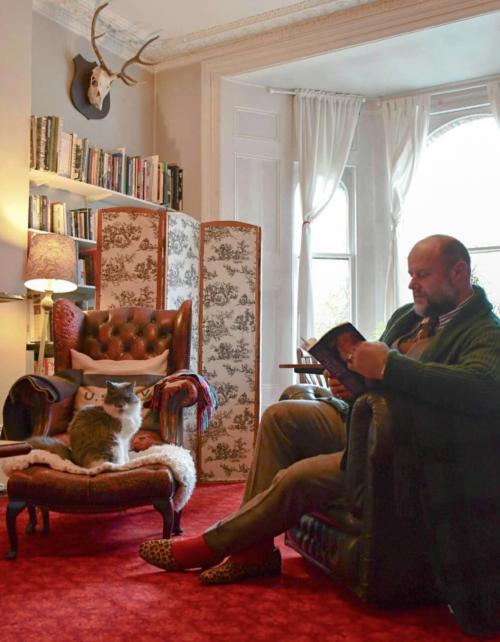
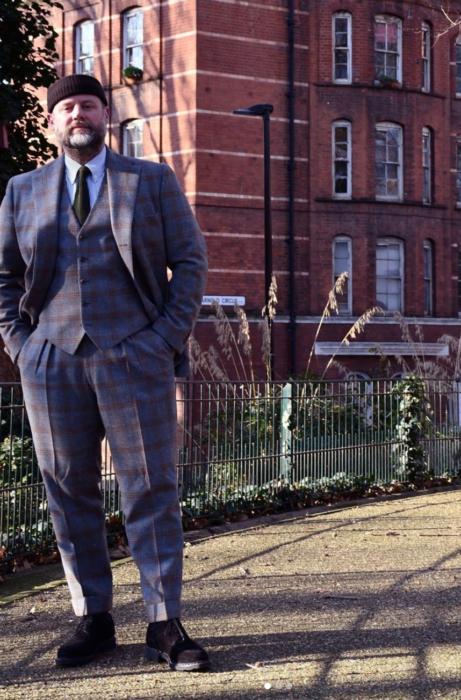
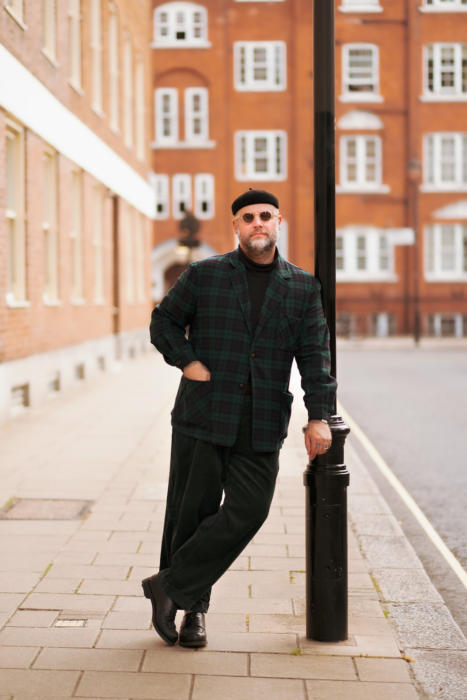
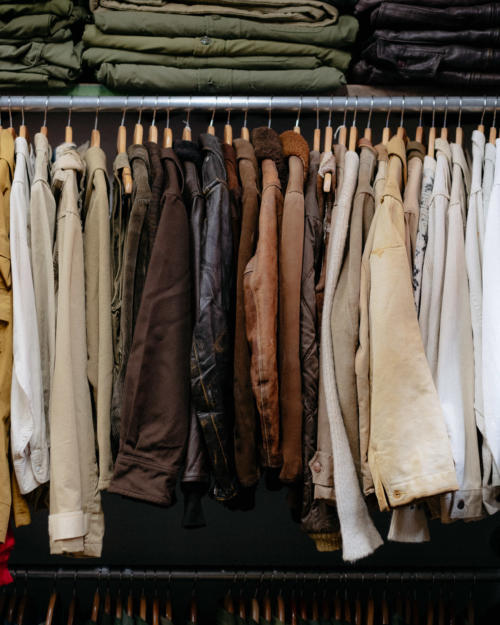
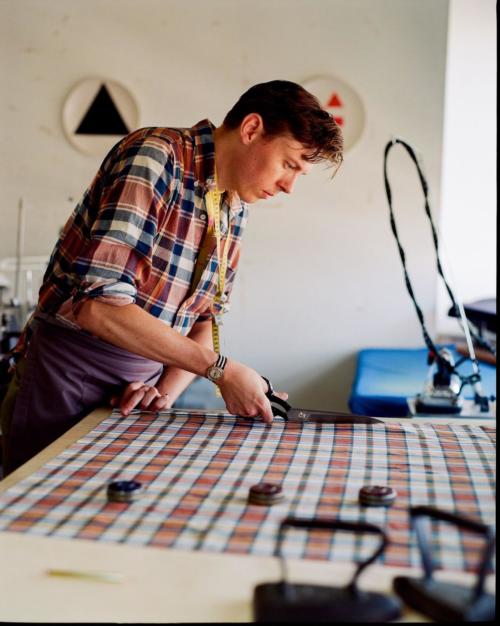
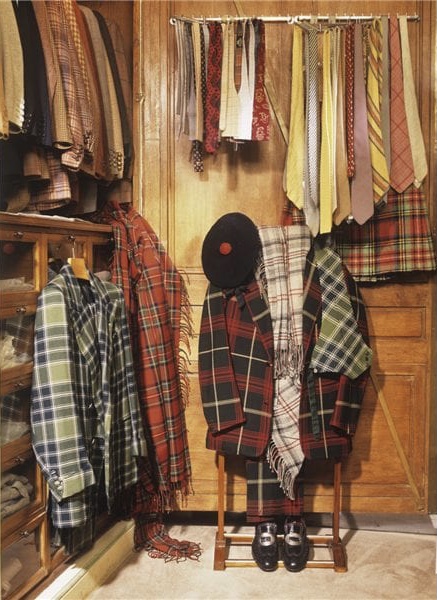


























A great read and great that you are contacting to Suited and Booted.
A great article. I completely agree but would also add second hand, (but not necessarily vintage) to the list. High quality, affordable and well looked after pieces are easy to find on ebay or specialised places like marktt. I would say this category accounts for at least 20% of my clothes and probably 90% of my accessories alongside custom and vintage pieces.
Thanks Fred. Yes, to be clear Tony was including second-hand in the same category as vintage. Hence the note at the end about the pieces he’s wearing – mostly second hand
Yes, after rereading I can see that clearly now. Thanks.
Interesting chap, but another piece on ‘sustainability’? It always surprises me that obviously intelligent people have such adamantine certainty that we are in a climate crisis/emergency (not all scientists agree with this by any means), and that taking a few old suits to the second hand shop, and making do with one new jacket, rather than our usual three will make any difference even if we are. I generally agree with curbing unnecessary indulgence as a sound lifestyle principle, but it could equally be argued that if we do all cut back on our consumption significantly, and live a ‘make do and mend’ existence, all we will do is put a lot of people, many in very poor countries, out of work. Anyway, I thought at least one person ought to post a note of skepticism here. And I hope this fine gentleman saves that magnificent three piece tartan suit!
Hey Phil,
I think let’s skip the debate over climate change, as there’s no way we’re going to have a productive discussion of it here.
But on the point of buying less, yes these kind of actions by consumers do make a real difference. And you say you agree with curbing too much indulgent spending anyway, so I’m not sure what you’re really arguing for. The same actions, just for different reasons?
The point about buying less putting people out of work is of course true, but also a complex economic topic – not one where the answer to one extreme is the other extreme, as you’re describing here.
Agree absolutely, no wish to clog the comments box with a – you right – almost certainly fruitless debate on ACC. Just thought it important to register one mildly dissenting comment, as you may have other readers who feel similarly. It just slightly rankles that it is automatically assumed we all agree with the ideas in this sort of piece.
What I am arguing for is honesty and rationality. Cutting back on your spending on unnecessary items, if it’s getting a bit out of control, is an admirable general principle. But be honest about why you are doing it – to save the planet (does the evidence really support that?), or to make your self feel better/less guilty about your comfortable lifestyle?
Anyway, nuff said.
Sorry, this comment needs checking. Having an adamatine certainty about climate chnage and being an intelligent person are not contradictory. Infact quite the opposite. I think, on balance any intellegant person would come to the conclusion that there is a climate emergancy based upon the evidence.
Thanks Joe, and happy to have one voice the other side. But much as I entirely (in fact violently) agree with you, I don’t think this is the right place for a discussion on climate change.
Cheers
Simon,
Without weighing in on a side of this discussion, I wanted to give my appreciation for your graciousness and your decision to keep political arguments out of the comment section. Those discussions are rarely, if ever, productive in a forum such as this.
Cheers
Thanks Ryan
“ 1/3 made to order, 1/3 vintage, 1/3 stock”…. Love that idea !
Although I’m not a vintage/ used clothes fan .
It’s given me the idea of approaching new purchases in some sort of proportion.
Hi Tony,
A really good read to finish the week on PS. I retired 4 years ago and there has been a long(ish) tail on my acquisitive instincts. In particular jackets from Drakes! I fully agree with your view on the breakdown of a wardrobe and relate to the transition to less formal wear. I am therefore much more appreciative of fewer single purchases. I also agree that the balance of garments from mainstream brands is a good supplement to a wardrobe- I too have items such a cashmere roll necks from Uniqlo that are well looked after (inc. storage bags in summer) and have to date lasted 4 years. And an M&S cashmere not yet washed to destruction after an even longer period of time. I think it’s easy to unjustly ‘look down one’s nose’ at these brands.
Do you write anywhere else as I really enjoy your articles?
One final point and please do not take this as a criticism, more a personal opinion. I do find the idolisation of the Duke of Windsor somewhat difficult as he was a man that had every advantage, yet (abdication aside) behaved in a way that would have seen been seen a treasonable in others. Simon has rightly pointed out that it’s possible to separate what someone wears from the person, artists and authors being examples. I do however think that given the suffering during WW2, treachery would be an exception. Similar to Kim Philby had a nice look in linen suits and George Blake in black roll necks. I’ll hop off the soap box now!
Now the big question is will my acquisitive instincts prevail in the face of the brown mock toe moccasins from Drakes!
Best Wishes
Thank you for the kind words, David… just a quick point on Eddie Windsor. No idolisation here. That photo of his wardrobe was selected as it illustrates exactly the kind of excess and overindulgence I’m arguing against! I definitely have a magpie character where “more is more” and looking at Eddie’s accumulation is a sobering reminder of unchecked acquisition. Thanks again, Tony
Hi , just a couple of points on the comments above.
1) Agree with Simon this is not really the place for climate change discussion. I do however think that ‘sustainability’ is almost ubiquitous in so many instances (which some may think is a good thing) that sometimes you just don’t notice and / or as such it’s simply losing impact in its over use. I actually sort of glaze when seeing it now and therefore nonetheless really enjoyed the article.
2) Is there really a difference between second hand and vintage? Or is it just semantics. I think with cars, furniture a certain age (not sure of the number) may define the difference.
I remember an old Harry Enfield Show (in UK) sketch where he was the owner of a shop called ‘ I saw you coming’, where the vintage was basically something secondhand that costs a lot of money!
Vintage used to mean something more than 20 years old – vint age in French.
It is used more broadly now, but it still generally means something pretty old. Most second hand, by contrast, is usually only one to a few years old.
With furniture and some other things, being an ‘antique’ usually requires it to be over 100 years old.
Re etymology of vintage, that would be nice and neat, but vintage actually originally meant harvest of grapes/vines, and then as obviously wine gets better became used for the age ‘the vintage of [year]’, before generally meaning something old.
Oh really? How annoying, it was a nice neat thing to reference
A good article on ways to resist the urge to buy to many things.
My wife and I recently read Mari Kondo’s book on tidying up. We applied her method for sorting and discarding possessions to our storage room and were shocked at how much unused and unloved stuff we were hanging on to.
I’ve since applied it to my clothing and have reduced it all by approximately 1/3. While asking yourself “Does this bring me joy” sounds a bit silly it really does work. I’ve gotten rid of things I never wear or that I find hard to combine into a pleasing outfit or that I just don’t like after all. Now I have a wardrobe of clothes that I love to wear and that work well with each other.
I know that’s our goal as readers of PS but it’s surprising how many of my failed experiments along the way were still hanging around in my closet.
+1 from me on the ‘does this bring me joy’ thing. It feels like the silliest thing in the world until you give it a go, but once you do it makes a lot of sense.
It also helps keep the regretful purchases down, too.
The problems comes when you love of your clothes irrespective of fit, use, etc. 😉
Yes that would make it difficult. And as other comments note you then have room again for new stuff. Always a temptation for me and I imagine many other readers of PS.
The trick for me is balance. The Kondo culling method works well for me, and I often discover things I forgot I had, or realize I don’t need another green sweater because I already have five. A couple of years ago I realized I only wear my bespoke jackets, and gave away most of my others. I haven’t missed them. When you trim your wardrobe to your best and favorite stuff, things get worn and have a chance to get some patina. You have closet space. On the other hand, I’ve also come to the conclusion that for me (and probably most readers of this site) the search for new clothes also sparks joy. I have enough bespoke jackets, but an edict that I will never again go to my London tailor to have something made removes a great joy from my life, and what would be the point of that?
Excellent point. I agree 100%:
I have enough bespoke jackets, but an edict that I will never again go to my London tailor to have something made removes a great joy from my life, and what would be the point of that?
Not so many years I gave no thought as to how a piece of clothing came to be on a hanger in front of me. I didn’t wonder if the person who made it was paid a decent wage, if they worked in a safe enviroment. If the cow who provided the leather for my jacket had been killed humanely. How much water was used to wash through my cotton and the impact on the enviroment that had. What happened to the chemicals that had produced the colours for my polo shirts. So many of us don’t think like that anymore. Permanent Style points us towards the artisan creative, shows us why we should invest in pieces that have been made to last but now we as the client are asking more of these guys. We want answers to the questions I never used to ask. What is so encouraging and is evidenced by this article is that many of the artisans are already way ahead of us and are making changes. If we think of Tony’s goods and chattels as being at the top of the “food chain” then as he moves them down the chain whether it be to vintage,second hand or charity shops his clothing will stand the test of time. My daughter manages a charity shop and anything that comes in from Primark or similar goes straight in the rag bag. It’s lost what my Mum used to call it’s gumption.
It is, of course, none of my business but Permanent Style should place a great deal of focus on sustainability. To do anything else would be frankly irresponsible. That would allow us to continue to buy what we want. Confident that when we passed it on it would remain fit for purpose.
1/3rd (or at least one quarter) of anyone’s wardrobe should reflect the extreme weather that – in 10 years, tops – will not be extreme in its frequency and consistency: it will merely be “weather.” REQUIRED: Legit tropical suiting and (conversely) full length shearling coats if you live anywhere with seasons. I have Russian shearling boots with retractable spikes in my coat closet — they work on ice, they let you operate in 30 (f) below weather. That is not science fiction…that world is already upon us.
https://www.nytimes.com/2021/07/20/briefing/heatwave-american-west-climate-change.html
It’s a good point, as increasingly, my wardrobe is becoming overpowered by the seemingly incessant spring, autumn and winter downpours. I write this as the Netherlands experience the ending of summer with the now traditional October monsoon. I appear to have a hot weather wardrobe – shorts , polos and linen…worn for two weeks in August… and a likely to be wet wardrobe.
Tony’s thoughts are always a refreshing addition to your texts, simon – more of them, please
Good to hear Marco
Downsizing, great in principle but every time I have a clear out (and I just had a huge one) I stand back proud of myself and then think, “Oh good, I have space for new stuff” It’s a problem I shall live with, no choice really.
For readers who are enthusiasts of the American Ivy League style (opinions vary, but it basically ended in the United States around 1967, with the arrival of flower power and “the summer of love”), I would suggest a look at Jake’s or Jake Wigham, the shirtmaker mentioned by Tony Sylvester in this post. The aesthetic as evidenced by the Jake’s website is spot on (right down to the use of dead-stock madras) and the backstory, a small company established by economic necessities of the pandemic, is compelling.
Interesting in these times of consciousness towards sustainability. Those of a certain age were often brought up on make do & mend. Along these lines it is good to alter old favourites to make them either fit a change in shape ( Bruce Bowyer on his favourite A&S jacket comes to mind ), or altering a shirt to become an over shirt with a straight bottom & side vents & maybe a flap to an existing pocket – all from the shirt tail. Also being mindful of sustainability on clothing; how can we have cloth from the UK going to Europe for clothing manufacture only to be for UK brands with an international market. Yet these brands have UK factories in The West Country manufacturing their shirts, can they not expand their UK supply chain to supply other MTM quality outfits? There’s little point in talking of sustainability with so much more trans national trade. Far better where possible to minimise the number of transits & lower the carbon footprint.Is it again perhaps better than ever to buy less but buy better.
Good points Steve.
On the manufacture in the UK, the issue is generally the lack of certain types of manufacturing. We don’t make shirts like they do in Italy, for example, and do no suit manufacture.
A better comparison is probably things like moving production from Italy to Asia for the same product – and of course there’s a much bigger difference in carbon footprint too.
Hi Simon,
I appreciate the lack of skills in certain sectors but maybe that is the sector that requires to be skilled up. Turnbull I & Asser & Drakes manufacture their shirts in Gloucester & Somerset, surely this is an area for growth in the UK for other quality clothing. It seems wasteful of resources to have Harris Tweed going to Italy for jackets to be sold in the UK, or Drake’s overshirts being made in Portugal & not in Somerset. It’s inevitably down to skills & costs, but there’s an impact on manufacturing in the UK & the loss of skills & the non development of new skills. It’s perhaps delusional to think we can carry on as we have in past decades, maybe the UK needs to try & develop more artisan skills as in Italy.
Many of us are constantly tempted by yet more clothes whilst not wearing regularly many others we have in the wardrobe. Generally we go to those clothes we feel comfortable with & that give us a sense of well-being. I’m certainly with age needing less, wear more of my wardrobe more often & try only to buy the best clothes that I can afford that I also have a need of; I dare say I will break this mantra but hopefully I will not make some whimsical purchases that are mistakes.
I agree. The issue really is consumers caring and buying on that basis. We had suit manufacture here for a long time, for example (Cheshire Bespoke) but it made suits expensive, and people weren’t prepared to pay for that. It’s why Gieves stopped using them, for instance. It’s down to consumers in the end.
You can see the same with shirt manufacture. Drake’s did buy that factory, but as they’ve wanted to offer cheaper shirts, or spend money on other things, they’ve increasingly moved production to Portugal. If their customers don’t mind that, then those skills will be lost gradually.
Interestingly, Italian makers actually receive very little government support for their crafts. It’s more the fact they’ve just been much more successful at developing strong brands in these areas, which then keep their own production there.
Hi Simon,
As they say ‘ you pay your money & make your choice’. I’m certainly more conscious to country of manufacture & try where possible to keep to UK manufacturing/artisans where possible, & so if I see a Drake’s shirt/over shirt from Portugal as opposed to Somerset I don’t consider it whereas before I might. It is not always possible though for other items. But it is good to see more artisan production & hopefully more will buy less but better & in a more considered capsule way to mix & match what you have & only purchase what will fit into that choice; rather like a well blended team as opposed to a collection of stars in competition with one another.
Permanent Style has done much to make its readers consider clothing & how to use it well & graduate to a better personal style that is much more considered. We’ll done Simon.
This has turned into a rather long comment but it’s something I’ve thinking about a lot lately…
‘Buy less but better’ is sound advice I’ve often repeated but seldom practised what I preached, tending to go a little mad in the sales, hoovering up items which a) were rather esoteric so only got occasional wear and b) perhaps only seemed like such great bargains because they were overpriced to begin with.
It’s taken me a long time to accept that having something that’s almost what I wanted for a fraction of the price isn’t really a saving if I end up treating it as a stopgap and still looking for that perfect piece, continuing to spend money (often on further bargain “near-misses”, like a series of darts circling a target but never quite hitting the bullseye!)
What I perhaps didn’t grasp was that buying better helps you buy less and that “better” isn’t just about grabbing bargains or eye-catching pieces that look beautiful in isolation but as often as not about really good quality staples.
Obvious really but it requires that initial investment and it’s great to have a site like PS as a guide to where and why it can be worth spending the extra and . (and also to enjoy admiring and discussing clothes without necessarily shopping or browsing)
My mindset now is clothing for life wherever possible: the sort of high-quality staples that will wear and age well and that I’ll have altered and repaired rather than replace.
E.g. since I got my BLA jeans, I don’t want more jeans because I want to wear the ones I’ve got. I fully intend to have them when I’m an old man (although whether I’ll still wear them or pass them on remains to be seen!)
Similarly I passed on a lovely vintage suede blouson at a great price because while it’s not really that similar, I know it would occupy a similar niche in my wardrobe as my Rogue Territory waxed canvas jacket so I either wouldn’t wear it or I’d wear the RT jacket, which I love, less: let someone else have and enjoy the suede one!
Another thing I’ve been trying is if I have something I think “needs replacing”, take it out of circulation and see how the rest of my wardrobe takes up the slack before automatically buying new.
Tailoring is another matter which I’ll perhaps save for a different post as this has become quite the essay already!
Thanks Tommy, nicely put. I remember those days of sale shopping. It takes such strength of will to say no and turn down the excitement of purchase.
Well done if you’ve become better at that!
I’ve found both winter and summer capsules a huge aids in buying smarter. The fall back of knowing you can dress well takes out so much of the stress of buying clothes.
By using the capsules,bafter an initial spurge last year, I’ve only bought seasonal additions, scarves,shorts, etc and have managed not to throw out a single item. Natural fibres are repaired, Socks darned.
Must of all…I enjoy it. The choice and thought. Thinking about what and how you use clothing.
Fantastic
Absolutely. Starting to put together a strong core wardrobe has helped me enormously in this respect. And also recognising my own changing tastes (generally speaking, shifting to colder colours and more subtle, classic lines, less overt styling than in my mod youth!)
i am guilty of this crazy way of shopping that you describe. although slowly I am changing it, and being more and more selective and restrained. i wholeheartedly agree with your view but would like to offer some justification.
In defense of sale shopping, yes i have bought fancy items because they were heavily reduced. Some (not all) of these items i have come to love and wear a lot (colourful ALD rugby top, suede CP slip ons). On the other hand, I have purchased some ‘core’ items at full price only to realise after a few wears that either the fit is bothersome (suede valstarino) or the weight is wrong (cushman sweatshirt). Similar with some of my tailored items, im constantly taking them to the tailor for minor alterations. Maybe its just me. but id say it does work both ways, to some degree.
my biggest problem is over-consumption. sales tempt me in to buying stuff that would be considered easy to wear and that i would like to try (suits in brown linen, chalk stripe flannel, solaro, black tie), but my lifestyle means that it never happens and it just sits there in my closet for months and months and months…until I am forced to re-sell them.
Zo,
We’ve all done these purchases only to realise it was a mistake. Often it’s appreciation of a good piece of clothing or material like a work of art, but once home we realise it doesn’t fit our lifestyle. That’s why PS is such a good forum to touch base with others facing the same dilemmas.